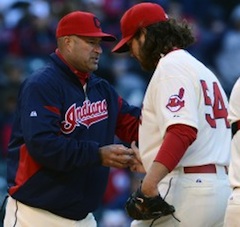 Indians Archive
Indians Archive  Opposite Field #3: "Rage Management" on Opening Day
Opposite Field #3: "Rage Management" on Opening Day
 For all the anticipation, pomp and circumstance, and lazy poetic clichés (“hope, like the songbird on the wing, returns anew in the spring”), there’s rarely anything special about an Opening Day game itself. In Cleveland, recent memories of the event have mainly congealed into a single, hazy vision of Mark Buehrle out-dueling Jake Westbrook in between frustrated clicks of the “refresh” button on your slow-as-molasses cubicle PC. But today? Ah, today was different! Today, we made history: 16 innings, 5 hours and 14 minutes—the longest Opening Day game in Major League history. And just think, if not for the stupidest statistic in professional sports, this thing might have been over before rush hour!
For all the anticipation, pomp and circumstance, and lazy poetic clichés (“hope, like the songbird on the wing, returns anew in the spring”), there’s rarely anything special about an Opening Day game itself. In Cleveland, recent memories of the event have mainly congealed into a single, hazy vision of Mark Buehrle out-dueling Jake Westbrook in between frustrated clicks of the “refresh” button on your slow-as-molasses cubicle PC. But today? Ah, today was different! Today, we made history: 16 innings, 5 hours and 14 minutes—the longest Opening Day game in Major League history. And just think, if not for the stupidest statistic in professional sports, this thing might have been over before rush hour!
What does it take to be a closer in the Big Leagues? A blazing fastball? Eh, not necessarily. A filthy splitter that thunks into the catcher’s mitt like a shot-put? No, that’s not a pre-requisite. How about a beard of ample fuzziness and tendency toward mildly eccentric behavior? Hmm, yeah, now you’re getting the idea.
Chris Perez, aka “Pure Rage”-- the furry-faced, long haired closer for the Cleveland Indians—entered the Tribe’s 2012 opener in the 9th inning with a comfy 4-1 lead; hand delivered brilliantly by the bald and currently beardless Justin Masterson (8 innings, 2 hits, 1 ER, 10 K). Now, Justin was still a shade under 100 pitches on the day, but I am not among the torch and pitchfork crowd claiming that Acta necessarily should have stuck with him. This is more about how the 9th inning as a whole unfolded, as dictated by the circumstances of the "save situation."
For the uninformed, a “save situation”-- as expressed in Rule 10.19 of the MLB’s Official Handbook for the Recently Relieved—is created by one of the following conditions:
1. A pitcher enters the game with a lead of no more than three runs and pitches for at least one inning
2. A pitcher enters the game, regardless of the count, with the potential tying run either on base, at bat, or on deck
If the lucky pitcher above finishes the game and his team wins, he is a very special boy indeed, and he gets a gold sticker called a “save.”
Now, because the ONLY task involved in getting a save is NOT BLOWING THE GAME, perfection is hardly the necessity. As various Cleveland closers have long proved, littering the bases and routinely giving up runs is just an understood part of the gig. In 2007, for example, the Indians boasted the American League’s #1 saves man—the great Joe Borowski. In 69 appearances that season, Joe Blow racked up a terrific 45 saves. He also had an ERA over 5.00 and a WHIP over 1.40, as his assortment of twirling garbage fooled few and intimidated fewer. Still, it was a successful campaign, regardless of the boos rained down upon him by a fan base clearly unaware that they had the league’s #1 fireman on their club.
Similar boos were sadly heard this afternoon at Progressive Field, when Pure Rage Perez—a noted giver upper of hits and walks—allowed too many of them in short succession, accidentally surrendering Cleveland’s previously “safe” 3-run lead in the process. It was an honest mistake and not an all-together unpredictable series of events-- considering that part of being a closer means having a longer leash than anyone else in the bullpen (because you're trying to get a save!!). And yet Tribe fans still jeered a fella for just being himself. Shame on you all!
Last season, Perez saved a career-high 36 games for the Indians. He also saw his strikeouts-per-nine-innings (SO/9) rate shrink dramatically for a third straight season, plummeting from 11.4 (2008) to 10.3 (2009) to 8.7 (2010) to 5.9 (2011). His strikeout-to-walk ratio was a pedestrian 1.50 last season, as well, and perhaps most importantly, he just LOOKED hittable. High pitch counts stemmed from an inability to put away hitters, and 7 losses resulted from a failure to stop the bleeding.
 With all that said, Chris Perez is not a bad Major League pitcher. Nor is he unworthy of coming into a game in the ninth inning to preserve a lead-- especially when the starting pitcher is making his first outing of the year in chilly April temps. The trouble is that Manny Acta is weirdly obligated to not only use Perez in this role, but to stick with him until the damage has been done. It doesn't matter what potential mismatches await him, or how weak his stuff is looking, or the Bullpen Mafia studs that might get overlooked in his favor.
With all that said, Chris Perez is not a bad Major League pitcher. Nor is he unworthy of coming into a game in the ninth inning to preserve a lead-- especially when the starting pitcher is making his first outing of the year in chilly April temps. The trouble is that Manny Acta is weirdly obligated to not only use Perez in this role, but to stick with him until the damage has been done. It doesn't matter what potential mismatches await him, or how weak his stuff is looking, or the Bullpen Mafia studs that might get overlooked in his favor.
While almost every other baseball statistic attempts merely to explain the natural goings on during a ball game (bases stolen, runs batted in, strikeouts thrown), the saves stat—perhaps inadvertently—has transcended its place in the boxscore; creating an element of strategy and game management that serves no purpose beyond serving the statistic itself.
Set to the default setting, every move in a baseball game boils down to giving one’s team the best chance at victory. Putting in a pinch runner with a winning run on second base, sending in a defensive replacement to prevent a winning run from scoring, etc. The thought is never about getting that runner an “SB" or the fielder a “PO.” It’s about putting yourself in line for a “W.” And yet somehow, the “save situation” exists on its own peculiar island in the baseball universe—accepted with little question by virtually every manager in the last 20 years, while the stat’s all-time leaders (Rivera, Hoffman, Smith) have reinforced the delusion by looking like the rule rather than the obvious exception to it.
Anyway, it’s quite possible that this entire thesis is merely an angry rant wrapped in a semi-formal criticism of managerial conventions. But it certainly isn’t an attack on Pure Rage. If anything, we should be thanking Chris Perez for making Opening Day memorable again. Decades from now, we’ll remember the “Opening Day game that wouldn’t end,” and we’ll think of Chris Perez—fur flying in the breeze—and smile.
- NBA Announces 2013-2014 Schedule
- Browns Ink Sharknado
- Sharknado A No-Show For Rookie Camp
- Trent Richardson Out Until Training Camp
- Browns Sign Brandon Jackson
- Carrasco Suspended Eight Games
- Browns Add to Wide Receiver Depth with David Nelson
- Browns Need to Learn from Past Draft Mistakes
- Browns Release Chris Gocong and Usama Young
- Browns Missing on Grimes Disappointing, But Not The End
The TCF Forums
- Chris Grant's first 3 drafts
Kingpin74 (Tuesday, January 21 2014 10:13 AM) - The 2014 Offseason Thread
googleeph2 (Tuesday, January 21 2014 9:36 AM) - 2015 Recruiting
furls (Tuesday, January 21 2014 6:57 AM) - Mike Brown
YahooFanChicago (Monday, January 20 2014 11:15 PM) - Movies coming out
HoodooMan (Monday, January 20 2014 9:34 PM) - 2014 Hoops Hockey Hijinx
jpd1224 (Monday, January 20 2014 4:44 PM) - 2014 Recruiting
jclvd_23 (Monday, January 20 2014 2:26 PM) - Wish List - #4 Pick
Hikohadon (Monday, January 20 2014 1:26 PM) - Official- Browns Coach Search/Rumors
OldDawg (Sunday, January 19 2014 6:48 PM) - #1 overall pick Anthony Bennett
TouchEmAllTime (Sunday, January 19 2014 1:28 PM)



